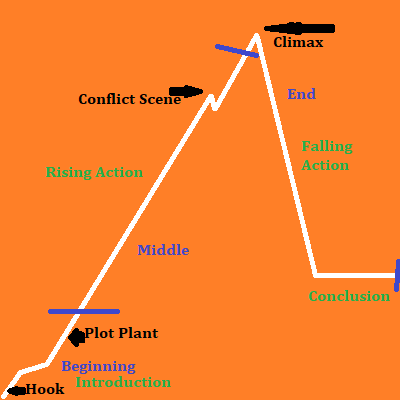 Some writers don’t plot. I am a confirmed plotter. I think that having a well-thought-out plot before beginning a book is almost always essential. Why?
Every writer has his or her own method for plotting. There is no right or wrong way to construct a plot, so long as it ends up following the basic plot diagram pictured here. However, I know some tried and true tricks that consistently result in exciting books. The Dragon’s Fire Series has gotten some rave reviews, including: captivating; shocking twists; gripping, fast-paced stories; thrilling. Plotting is a skill I fine-tuned with my mentor about 25 years ago. He taught me:
No matter what genre you are writing, every story follows the same basic form: beginning, middle, and end. Each part contains certain elements that contribute to flow and drive the action forward. The beginning must introduce a conflict of some sort—the protagonist must have a problem to resolve. A novel is not a memoir. The story must have direction and purpose. The middle, or rising action, must show the steps the protagonist takes to solve his problem, building interest and excitement all the way through. The end begins with the climax—a battle, a turning point, the most exciting part of the book. Does the protagonist win or lose? The story must then resolve satisfactorily. Your ending can be happy, sad, or something between, but the plot should conclude in a way that doesn’t leave the reader hanging, wondering what comes next. There’s a difference between leaving readers wanting more and leaving them feeling cheated because there should have been more! Finish this story, even if you leave some dangling threads for a sequel. Following a formula in writing a plot can be stifling to creativity. It’s no fun to shove your story into a box. The first step in plotting is to outline your story in point form. You don’t have to start at the beginning or work in chronological order. Write down whatever you’ve got and build on it. Once you have the beginning, middle, and end outlined, you can flesh your plot out. Look for these key elements: 1.) Does your plot have an interesting/exciting hook? Grab your reader’s attention on the first page. 2.) Does your main character have a clear task or goal to achieve? 3.) Do you present that task or goal early in the story, preferably within the first chapter? 4.) Does your rising action follow a logical progression? It should build gradually, providing motivations for your protagonist to continue his journey and increasing tension as you head toward the climax. 5.) Is the climax exciting? Does it pay off everything you’ve built up during the story? Does your main character achieve his goal through his own merits? 6.) Does your story conclude reasonably quickly after the climax, providing a satisfying ending? If your story is missing any of these things, tweak your plot until it includes all the elements. Subplots should drive the main plot forward and tie smoothly into the ending. If they don’t, they probably don’t belong. A fun element that I usually like to include is a plot plant. A plot plant is an almost-unnoticed element of the story that comes into play in a big way during the climax. A plot plant should appear early in the narrative without much fanfare so that the reader accepts its presence without paying it much attention. (E.g., Dorothy’s ruby slippers in The Wizard of Oz.) I also like to write an exciting, direct conflict between protagonist and antagonist toward the “end of the middle” of the story. For excitement and tension, this scene is almost climactic. At the end of it, things are usually looking bad—the villain has taken the upper hand and shoved the protagonist into a corner. It’s the point of no return. The protagonist is on an inexorable path to the end. Once I’ve written down my story ideas, I check it with the plot framework for all the points I’ve listed above. What if the story doesn’t plug into my “master outline” correctly? In that case, I’ll change the order of events or strengthen my conflict or climax. Sometimes something is missing, so I add new ideas and scenes. Sometimes I’ll discover that an element I like doesn’t fit the story and needs to go. But after some tweaking, I end up with a plot that employs every essential component of great storytelling, makes logical sense, and makes me excited to start writing! And then my characters change it. Your plot will change as you write your story, though the essential elements should still be present. You'll add things, and you'll take them away. Plots aren’t prisons. Use them as a road map. Explore, create, and have fun doing it!
0 Comments
Leave a Reply. |
Archives
March 2024
EventsCheck out my interview with blogger Fiona Mcvie! https://wp.me/p3uv2y-75n
|